
|
|
Identified American Brands |
Move mouse cursor over images to identify which images will expand (pointer changes to a hand)
See bottom of page for image copyright information
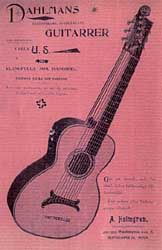 |
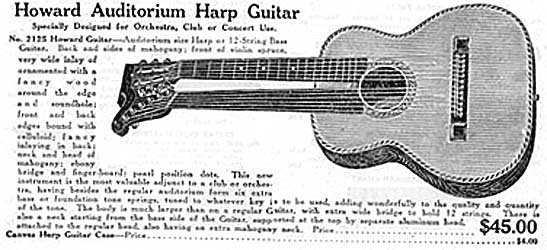 |
| Dahlman patented this form of harp guitar. Most models seen are labeled Charles Akeson. | Wurlitzer catalog, date unknown |
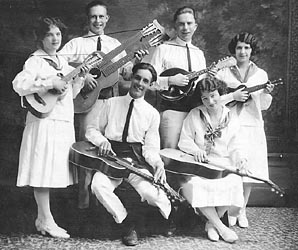 |
||
| Lyon & Healy catalog, c.1917 | This is most likely an L&H American Conservatory harp guitar, but a few other makers made this same form. |
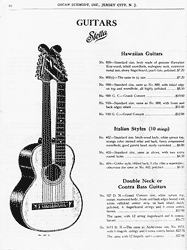 |
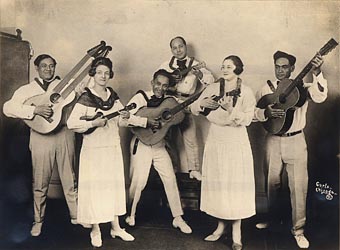 |
|
Oscar Schmidt catalog, c.1921 |
The Ellis
Royal Hawaiians, c 1920's, with a Stella harp guitar player (image courtesy of the Special Collections Department, University of Iowa Libraries) |
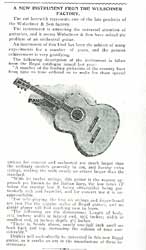 |
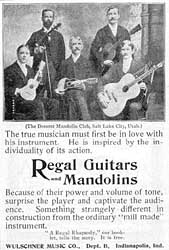 |
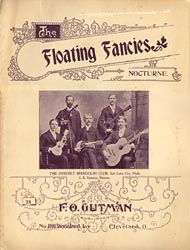 |
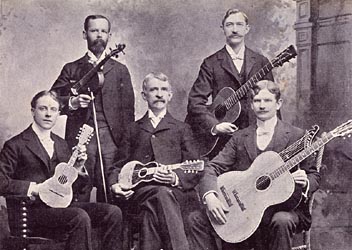 |
| This form
of Regal harp guitar is a brand name of Emil Wulschner & Son of
Indianapolis - or specifically, from one or more of the evolving/branching
Wulschner/Regal companies - somewhere in the period between 1899 and 1904. This ad is from Wulschner & Sons, and is dated 1900 by Michael Holmes. |
This ad for "Regal Guitars and Mandolins", from the Wulschner Music Company appeared in the September, 1900 issue of "Munsey's Magazine." The photo is of the Deseret Mandolin Club, Salt Lake City, Utah. | In the same year (1900), this piece of music by C.E. Pomeroy (center) was published by F.O. Gutman. | This image provides much better detail, not only of the Regal harp guitar, but of the alleged Regal mandolins - which resemble the S.O. Allison mandolinettos (shown on my Mandolinetto page). |
|
This and the
following two pictures are from an 1897 Washburn catalog. The implication
is that these are 3 Washburn harp guitars, but what strange models! All
are completely unique, have never (to my knowledge) been seen offered in
any catalog, or have additional specimens known. |
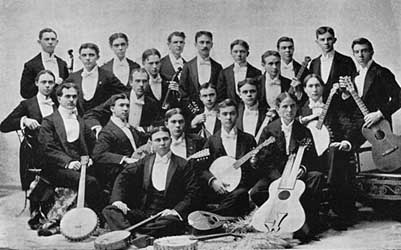 |
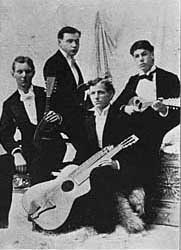 |
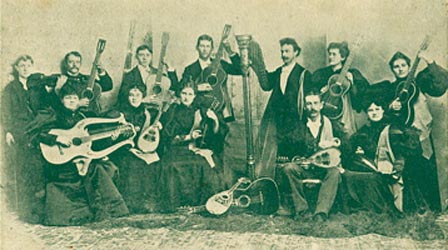 |
| La Harmonia
Orchestra The same Washburn lyre harp guitar. |
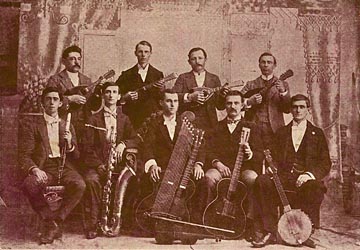 |
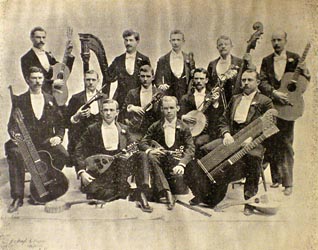 |
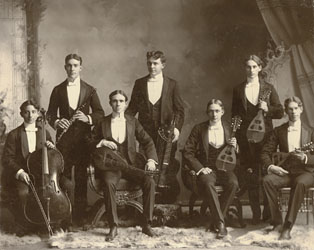 |
| The Aeolian
Mandolin Orchestra, Guthrie OK, 1898 This is undoubtedly a Harwood specimen. |
From the January, 1895 Cadenza, this remarkable image shows an entire Harwood ensemble, and shows us that not only the large 12-bass model was introduced before 1895, but that they had also created a "slab-neck sub-bass"-style harp guitar before the Regals shown above. | This unlabelled photo shows another group with the same 6-bass "slab-neck" Harwood |
| (See also Harwood Harp Guitars). | ||
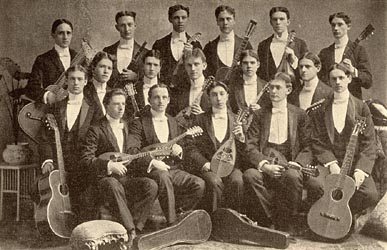 |
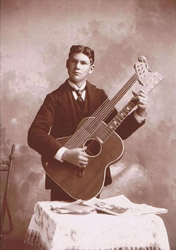
|
|
| Minneapolis, 1897 mandolin club with perhaps the same model | And a seemingly identical Harwood model | |
| Steinway Mandolin Orchestra | Chicago Mandolin Orchestra and Bohmann's Quartett, c.1899. |
| The Florentine
Troubadours, Portland OR, 1898 This is almost certainly another one-of-a-kind Bohmann harp guitar. |
The 6-string guitar is an early Bohmann, the harp guitar I now believe to be by Tony Biehl of Iowa, late 1890's |
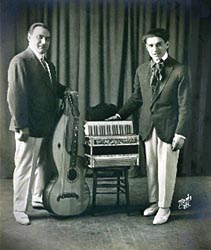 |
|
Frank Lucanes (on right) was the older, accordion-playing brother of the famed guitarist Nick Lucas. Around 1915, Frank joined a vaudeville act called The Three Vagrants. At left is the group's guitarist, John Bergamasco, who played a "Majestic" brand harp guitar built by another Italian, Gaetano Puntolillo. The trio recorded several 78s (with harp guitar) - five of which can be heard here. (copyright NickLucas.com) |
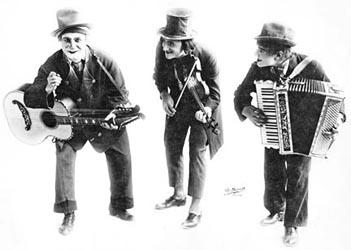 |
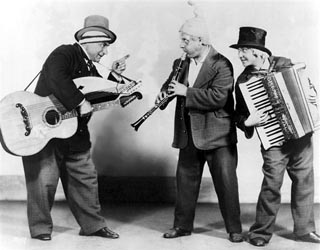 |
|
| The Three Vagrants in costume | In 1928 with A. C. Mignella on clarinet and (Josephine
Bergamasco on accordion (copyright and courtesy Richard Harris) |
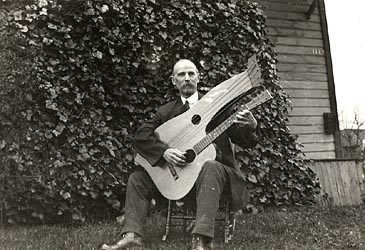 |
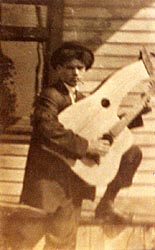 |
|
These remarkable photos depict a home-made harp guitar obviously inspired by a Knutsen. The gentleman at left is Edwin Horace Eaton, born in Brecksville, Illinois in 1859. The picture is thought to be from 1910-1915, and taken in Michigan. At right is Edwin's son, Arleigh (born 1891) with the same instrument about 1915. The family photos come from Edwin's granddaughter Shirley Eaton Louis, who says that her father Ray (Arleigh's older brother) was a woodworker and instrument builders, creating various stringed instruments for the family's use. It is likely that Ray built the harp guitar, though Edwin may have been a carpenter as well. Ray was in Munising, Michigan in 1910 and in Los Angeles in 1920. As the instrument was apparently built before 1915, and the family had not relocated to Washington (by 1925), it's hard to say where Ray might have seen a Knutsen (likely Michigan). Ray, Arleigh and another brother, Edwin H. Eaton Jr., played Ray's instruments on the radio in 1940. Shirley has been in contact with harp guitarist William Eaton (see below), as there is the possibility of a distant family connection! Photos courtesy and copyright Shirley Eaton Louis. |
|
| And now, a segue to 1982.... | |
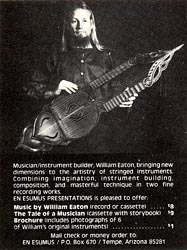 |
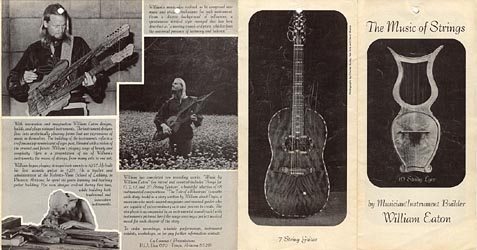 |
|
William Eaton's 1982
Frets ad and 8-page folded brochure may be the first we see of the
current generation of harp guitarists. |
|
|
If you enjoyed this page, or found it useful for research, please consider supporting Harpguitars.net so that this information will be available for others like you and to future generations. Thanks!
|
|
If you enjoyed this article, or found it
useful for research, please consider making a donation to The
Harp Guitar Foundation, |
|
|
|
All Site Contents Copyright © Gregg Miner,2004-2020. All Rights Reserved. Copyright and Fair Use of material and use of images: See Copyright and Fair Use policy. |